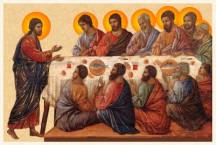|

CENTERING PRAYER
Gratitude
to Fr. Thomas Keating &
Contemplative Outreach
for much
of the following material
And to Rev Dr Michael Milner for
the article at the bottom of the
page:
"Lectio Divina & Centering
Prayer:
Keys
to Deeper Communion with God"
Click Here
Click Here for details about our
Centering Group & Book
Club
Centering Prayer is a Contemplative Meditation practice that
focuses on the inner-divine, the
God-within.
It is derived from the teachings of the
ancient middle eastern desert monks.
Today, Centering Prayer is being
practiced with profound results by
people of all faiths, including
Christians, Muslims, Jews, Buddhists,
Hindus, Taoists, New-Age believers,
Pagans and more. No matter what
spiritual tradition you embrace, if you
are looking for a form of meditation
that focuses on the presence and action
of God-within and leads to divine-union, Centering Prayer is a wonderful and
effective practice to explore!
Centering Prayer Guidelines
1. Choose a sacred word (of one
or two syllables) as the
symbol of your intention to
consent to God’s presence and
action within.
2. Sitting comfortably and with eyes closed, settle
briefly and silently introduce
the sacred word as the symbol of
your consent to God’s presence
and action within.
3. When engaged with your thoughts*, return
ever-so-gently to the sacred
word.
4. At the end of the prayer period, remain in silence
with eyes closed for a couple of
minutes.
*thoughts include body
sensations, feelings, images,
and reflections
Explanation of the Centering
Prayer Guidelines
I.
Choose a sacred word as the
symbol of your
intention to consent to God’s
presence and
action within.
1.
The sacred word expresses our
intention
to consent to God’s presence and
action within.
2.
The sacred word is chosen during
a brief
period of prayer to the
Spirit. Use a
word of one or two syllables,
such as:
God, Light, Spirit, Jesus, Abba, Father,
Mother, Amen.
Other possibilities include:
Love, Listen, Peace,
Mercy, Let Go, Silence,
Stillness, Faith, Trust
3.
Instead of a sacred word, a
simple inward
glance toward the Divine
Presence, or noticing
one’s breath may be more
suitable for some
persons. The same guidelines
apply to these
symbols as to the sacred word.
4.
The sacred word is sacred not
because of
its inherent meaning, but
because of the
meaning we give it as the
expression of our
intention to consent.
5. Having chosen a sacred word,
we do not
change it during the prayer
period because
that would be engaging thoughts
II. Sitting comfortably and
with eyes closed,
settle briefly and silently
introduce the sacred
word as the symbol of your
consent to God’s
presence and action within.
1.
“Sitting comfortably” means
relatively
comfortably so as not to
encourage sleep during
the time of prayer.
2.
Whatever sitting position we
choose, we
keep the back straight.
3.
We close our eyes as a symbol of
letting
go of what is going on around
and within us.
4.
We introduce the sacred word
inwardly
as gently as laying a feather on
a piece of
absorbent cotton.
5.
Should we fall asleep upon
awakening
we continue the prayer.
III. When engaged with your
thoughts,
return ever-so-gently to the
sacred word.
1.
“Thoughts” is an umbrella term
for every
perception, including body
senstations, sense
perceptions, feelings, images,
memories, plans,
reflections, concepts,
commentaries, and spiritual
experiences.
2.
Thoughts are an inevitable,
integral and
normal part of Centering Prayer.
3.
By “returning ever-so-gently to
the sacred
word” a minimum of effort is
indicated. This is
the only activity we initiate
during the time of
Centering Prayer.
4.
During the course of Centering
Prayer, the
sacred word may become vague or
disappear.
IV. At the end of the prayer
period, remain in
silence with eyes closed for a
couple of
minutes.
1.
The additional 2 minutes enables
us to bring
the atmosphere of silence into
everyday life.
2.
If this prayer is done in a
group, the leader
may slowly recite a prayer such
as the Lord’s
Prayer, while the others listen.
Some Practical Points
1. The minimum time for this
prayer is 20 minutes.
Two periods are recommended each
day, one first
thing in the morning and the
other in the afternoon or
early evening. With practice the
time may be
extended to 30 minutes or
longer.
2. The end of the prayer period
can be indicated by
a timer which does not have an
audible tick or loud
sound when it goes off.
3. Possible physical symptoms
during the prayer:
a. We may notice slight pains,
itches, or
twitches in various parts of the
body or a
generalized sense of
restlessness. These are
usually due to the untying of
emotional knots in
the body.
b. We may notice heaviness or
lightness in
our extremities. This is usually
due to a deep
level of spiritual
attentiveness.
c. In all cases we pay no
attention and ever so
gently return to the sacred
word.
4. The principal fruits of
centering prayer are experienced
in daily life and not during the
prayer period.
5. Centering Prayer familiarizes
us with God’s first
language which is silence.
Points for Further Development
1. During the prayer period,
various kinds of thoughts
may arise:
a. Ordinary wanderings of the
imagination or
memory.
b. Thoughts and feelings that
give rise to attractions
or aversions.
c. Insights and psychological
breakthroughs.
d. Self-reflections such as,
“How am I doing?”
or, “This peace is just great!”
e. Thoughts and feelings that
arise from the
unloading of the unconscious.
f. When engaged with any of
these thoughts
return ever-so-gently to the
sacred word.
2. During this prayer we avoid
analyzing our experience,
harboring expectations, or
aiming at
some specific goal such as:
a. Repeating the sacred word
continuously.
b. Having no thoughts.
c. Making the mind a blank.
d. Feeling peaceful or consoled.
e. Achieving a spiritual
experience.
Ways to Deepen Our Relationship
with God
1.
Practice two 20–30 minute
periods of centering prayer
daily.
2. Listen to the Word of God in
Scripture and study the book "Open Mind,
Open Heart".
3. Select one or two of the
specific practices for everyday
life as suggested in Open Mind,
Open Heart, chapter twelve.
4. Join a weekly centering
prayer group.
a. It encourages the members of
the group to persevere in their
individual practices.
b. It provides an opportunity
for further input on a regular
basis through tapes, readings,
and discussion.
c. It offers an opportunity to
support and share the spiritual
journey.
What Centering
Prayer Is and Is Not
a. It is not a
technique but a way of
cultivating a deeper
relationship with God.
b. It is not a relaxation
exercise, but it may be quite
refreshing.
c. It is not a form of
self-hypnosis but a way to quiet
the mind while maintaining its
alertness.
d. It is not a charismatic gift
but a path of transformation.
e. It is not a para-psychological
experience but an exercise of
faith, hope, and selfless love.
f. If is not limited to the
“felt” presence of God but is
rather a deepening of faith in
God’s abiding presence.
g. It is not reflective or
spontaneous prayer but simply
resting in God beyond thoughts,
words, and emotions.
Gratitude to Fr. Thomas Keating
& Contemplative Outreach for much
of the following material
https://www.contemplativeoutreach.org/

Lectio Divina
& Centering Prayer
KEYS TO DEEPER COMMUNION WITH GOD
BY
THE MOST REV. DR. MICHAEL MILNER, D.MIN.,
TH.D., PH.D.
Our
planet is waking up, the struggle for
liberation is on, and a new global
culture is emerging which yearns to be
free from the enslaving political,
ideological and religious constraints of
the past. In Christ there is power,
wisdom and grace to make the dream a
reality. But centuries of religious
repression and dogmatism have blinded
many people to the liberating power of
Christ. They are turning to
non-Christian paths, the new age
movement, and secular psychology for
guidance.
Granted, the Christian Tradition
does not have a monopoly on wisdom, and
there is useful knowledge to discover
outside of her walls. But we who serve
as shepherds to the flock have a
responsibility to provide adequate
spiritual direction for those who seek
it. Our failure to do so has caused
large numbers of our brothers and
sisters in Christ to turn away from the
Christian community. Spiritual seekers
today are not content with moving church
services and the preachers’ intellectual
knowledge “about” God. They want to know
God personally by direct experience.
Divine union is the root of true
liberation, and if Christian leaders do
not point the way, others will step in
to fill the gap, drawing many sincere
believers away from the Christian
Tradition. To heal the breach and
respond to the needs of modern seekers,
we must revive the Christian
contemplative tradition, offering it as
a Christ-centered mysticism for all who
seek direct communion with God.
Contemplative prayer is simply
resting in God, silently absorbed in the
Divine Presence, beyond thoughts, words,
and images. Immersed in Divine Love, we
forget ourselves, and a process of
interior transformation begins, which
leads, if we consent, to an abiding
state of divine union. In this process,
a total restructuring of consciousness
occurs. We come to recognize and
experience God within us, as the very
ground of our being, and simultaneously,
we begin to see God everywhere, in,
through and beyond all that exists. We
even discover God’s presence in the
people we have felt most alienated from,
and we find the ability to love and to
serve them. Thus, contemplative prayer
works to bring healing to a world torn
by prejudice, hatred, and greed.
Contemplative prayer is a gift of
God, a spontaneous unfolding of the
grace of Christ within us, and no
technique can produce it. But there are
things we can do to prepare ourselves
for the gift, instead of waiting for God
to do it all. For instance, certain
Eastern methods can help lay the
groundwork for contemplation by calming
the mind and harmonizing the body with
the spirit (a possibility long ignored
in the West). Some Eastern practices can
also help us channel and integrate the
spiritual energy released in
contemplation. But Eastern traditions
generally make the assumption that the
proper spiritual technique will
methodically and systematically produce
Divine Union. In the Christian Tradition
we understand and affirm boldly that
communion with God is purely a gift of
grace, by invitation only.
So while many Eastern methods and
meditative practices are not harmful and
may even be helpful, true Christian
contemplation is the fruit of our
relationship with Christ, and
cultivating that relationship must be
our primary focus. One of the best ways
to do this is the practice of lectio
divina, literally “divine reading,” a
way of prayer used by both monks and lay
people in the first Christian centuries
and the core of the Benedictine Prayer
Tradition to this day. Lectio divina has
four stages. It begins with 1) reading
or listening a passage of Scripture
(Latin: “lectio”), followed by 2)
reflection or “meditation” on the text
(Latin: “meditatio”), leading to 3) the
spontaneous prayer of the heart as we
communicate with God about what moved us
during our reading and meditation
(Latin: “oratio”), and finally to 4)
interior silence also known as
Contemplation or simply resting in the
presence of God (Latin: “contemplatio”).
Initially, viewed as the normal
experience of anyone practicing lectio,
by the sixteenth century, contemplation
came to be regarded as something for
only extraordinary souls, and the
contemplative tradition was suppressed.
This persisted well into the twentieth
century, when widespread interest in
Eastern meditation and other forms of
mysticism sparked a contemplative
renewal in the Church. From this emerged
“Centering Prayer,” a contemporary
presentation of an ancient method used
by the Desert Fathers to move from the
first three phases of lectio to the
final stage of resting in God. It is
especially helpful for Western people
whose tendency to be too analytical
makes it difficult to move from
reflection to spontaneous prayer, and
from spontaneous prayer to interior
silence.
To PRACTICE CENTERING PRAYER:
1. Choose a sacred word of one or two
syllables which symbolizes your
intention to consent to the presence and
action of God within. (The word could be
Jesus, Yahweh, Abba, Spirit, Peace,
Silence, etc.).
2. Sit comfortably, with eyes
closed. Silently introduce the sacred
word as the symbol of your consent to
the presence and action of God within.
(You need not repeat it continually; it
may fade out, become vague or
disappear).
3. If you are caught up in any thought,
feeling or perception, very gently
release it, and return to the sacred
word.
4. At the end of the prayer time,
remain in silence with eyes closed for a
couple of minutes, before resuming
activity.
You will probably be aware of a
continual stream of thoughts and images.
This is not an obstacle to centering
prayer. Make no attempt to repress them.
Just keep letting them go, and rest in
the presence of God, by returning ever
so gently to the sacred word.
Before you decide if centering
prayer is working for you, commit
yourself to do it for at least twenty
minutes, twice a day, for a month.
Contemplative grace is very subtle, and
you may not perceive what is happening
during the time of prayer. So do not
measure it by the experiences you have
in prayer, but by the fruit it bears in
your life, the fruit of peace which
comes from yielding daily to God’s
presence at the deepest core of your
being.
If we balance the practice of Lectio
Divina and Centering Prayer with
faithful participation in the liturgy
and Sacraments of the Church, and a life
of loving service to others, we will be
transformed and become healers of the
Church and of the world.
RECOMMENDED READING:
Hall, Thelma. Too
Deep for Words: Rediscovering Lectio
Divina (New York: Paulist Press,
1988).
Keating, Thomas. Open
Mind, Open Heart (Continuum).
The most excellent book I know of on
centering prayer!
Keating, Thomas. Invitation
to Love: The Way of Christian
Contemplation (Continuum).
Everything by Thomas Keating is
highly recommended!
Copyright © 2003 Maclin R. Milner, Jr.
All Rights Reserved

|



